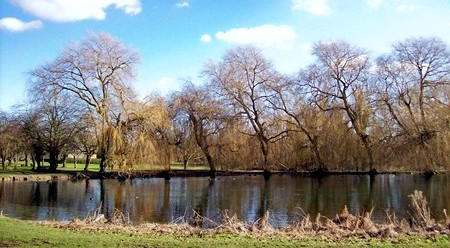|
The source of Bourne's
water

The amount of water produced in
Bourne is estimated at between three and four million gallons a day,
emanating from St Peter's Pool and various boreholes that have been sunk
around the town. Most of it is now used to supply a large catchment area
that includes Spalding and Peterborough and is under the
administration of Anglian Water.
We have a most interesting summary of the reason for this abundance of
water in a town that does not get a high rainfall from Joseph J Davies
(1856-1920), a local schoolmaster and historian, from his book Historic
Bourne which was published in 1909 describing the town's water supply.
"The excellence of this apparently inexhaustible supply of Bourne water is
a priceless industrial asset", he wrote. "The rainfall for Lincolnshire is
comparatively small, the annual average for Grantham and Boston being 23
inches. That of Bourne is 19 inches. Thus Bourne may make the paradoxical
boast of being almost the driest town with the most abundant natural water
supply. As is well known, much of the rainfall soaks through the soil into
the rocks, percolating freely until it reaches the zone of saturation.
"The importance of this shortage of underground water is obvious. The
water rises by capillary attraction in the permeable rocks, as oil rises
in a lamp wick. One cubic yard of Lincolnshire limestone is said to hold,
in saturation, 28 gallons of water. If a bore be made down to the
saturated rock, the pressure of the water from the higher levels forces
the flow of water up the bore to the height of origin.
"The source of Bourne water supply is the Lincolnshire limestone which
forms the table land, rising from Lincoln (200 feet) to Witham (400 feet)
and above Bourne 100 feet. The dip of bend of these rocks is from NW to
SE. The pressure therefore increases toward the centre at Bourne. A great
upward bend at Scottlethorpe brings the rock 120 feet above the ground
level of Bourne on the margin of the fenland. Thus the town is supplied by
natural hydrostatic pressure.
"The gathering ground for our Bourne water trends from Somerby and Ropsley,
southward.: and from the high western table land where the limestone
escarpments reach a height of 400 or 500 feet, and slope gently outward.
"Thus the water percolates to our lower level. This vast natural reservoir
fills until the level of saturation is higher in the west than in the
east. Hence, when the overlying oolite clay is bored through, the water is
forced through the bore by the pressure of the immense descending stream.
"The Wellhead, or St Peter's Pool, is a natural spring, yielding 1½
million gallons a day. This supply of beautiful water feeds the Glen.
Other local borings yield probably 2½ million gallons a day."

Go to:
Main Index Villages
Index
|
